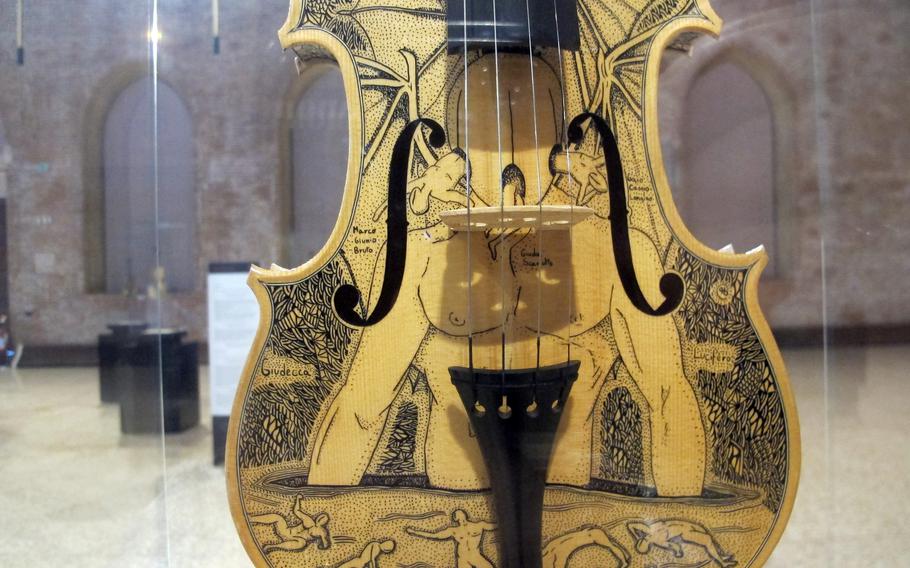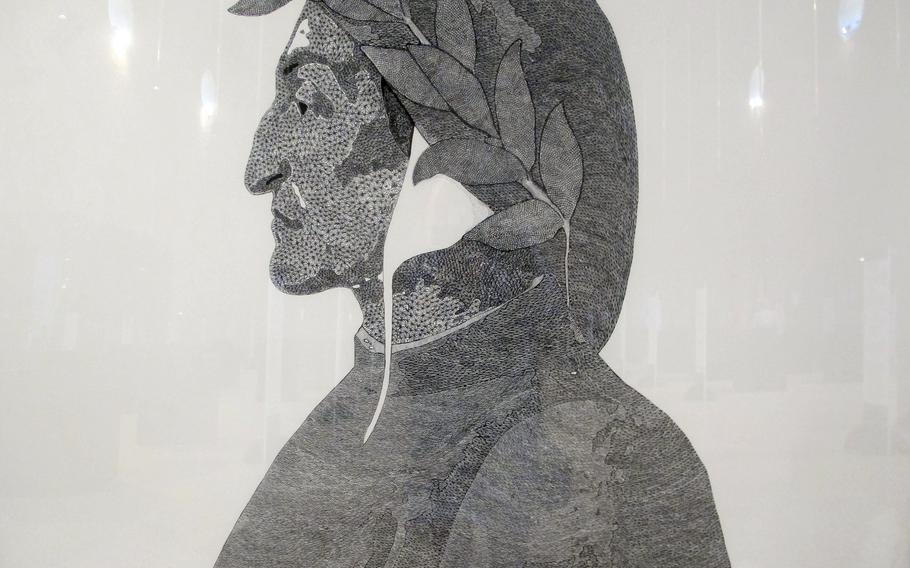
A depiction of Lucifer trapped in ice in the center of the lowest level of hell is one of 34 stringed instruments making up an art exhibit in Vicenza, Italy based on Dante's "Divine Comedy." "Infernus" runs through Aug. 31. (Nancy Montgomery/Stars and Stripes)
One cello and 33 violins, all heavily inked with signs, symbols and images illustrating a famous epic poem about a terrifying adventure in hell, are on display this summer in the cool, vast hall of the Palladian Basilica.
The exhibition “Infernus,” by young Vicenza-born artist Leonardo Frigo, is the first pandemic post-lockdown art exhibition in the basilica, Vicenza’s most famous building, in more than a year. It maps out in ink and text the 34 cantos or sections of “Inferno,” the first part of Dante Alighieri’s famous 14th-century epic poem the “Divine Comedy.” It runs through Aug. 31.
Dante, you may recall from English class, explored in his poem the nine concentric circles of torment in hell suffered by a variety of sinners, including murderers, hypocrites, seducers, gluttons, opportunists, fraudsters and the faithless, among others. He’s accompanied on his journey by the ancient Roman poet Virgil; the two were clued in to what awaited them as early as the third canto when they read the inscription on hell’s gate: “Abandon all hope, ye who enter here,” it said.
This does not apply to exhibition goers. Although 34 musical instruments covered front and back in graffiti-like markings, along with 34 explanatory signs in Italian and English, do make for a lot of reading.
But the sight of the beautiful instruments lined up in the huge, domed hall dating to the 1500s is stunning, and the meticulously painted images are interesting. The explanatory text provides a lively exposition of medieval demonology and theology, and highlights Dante’s beautiful language.
One surprise is that at the center of hell in its lowest level, Lucifer, formerly God’s fairest angel condemned for his treacherous rebellion, has become a giant beast with three faces trapped waist-deep in ice, not fire.
It took Frigo five years to paint the violins and cello. He’s been painting stringed instruments for nearly a decade, according to the exhibit curation, combining art, literature and music in a single object, one that “winks” at tattoo and street art.

Included in the art exhibit "Infernus" at the Palladian Basilica inspired by Dante's "Divine Comedy" is a portrait of Dante. He is widely considered the greatest Italian writer, with the "Divine Comedy" his masterpiece. Still, he was forced out of Florence in a political dispute and died in Ravenna in 1321. (Nancy Montgomery/Stars and Stripes)
The exhibition comes in the year marking the 700th anniversary of the death of Dante, widely considered Italy’s greatest writer.
“I want this project to represent a sign of true rebirth and a push towards the future: an emotional journey that helps us to ‘see the stars again,’” Frigo told La Milano. He was referring to the last line in Dante’s Inferno, when he and Virgil push up from hell through a tunnel: “Where we came forth and once more saw the stars.”
Address: Palladian Basilica, Piazza dei Signori, 36100 Vicenza VI
Hours: 10 a.m. to 6 p.m. Tuesday to Sunday
Admission: 5 euros; 2 euros for Vicenza residents (with ID card); free for under 18.
Information: Online: infernus2021.com; facebook.com/IViolinidInfernus; Phone (+39) 0444 964380.